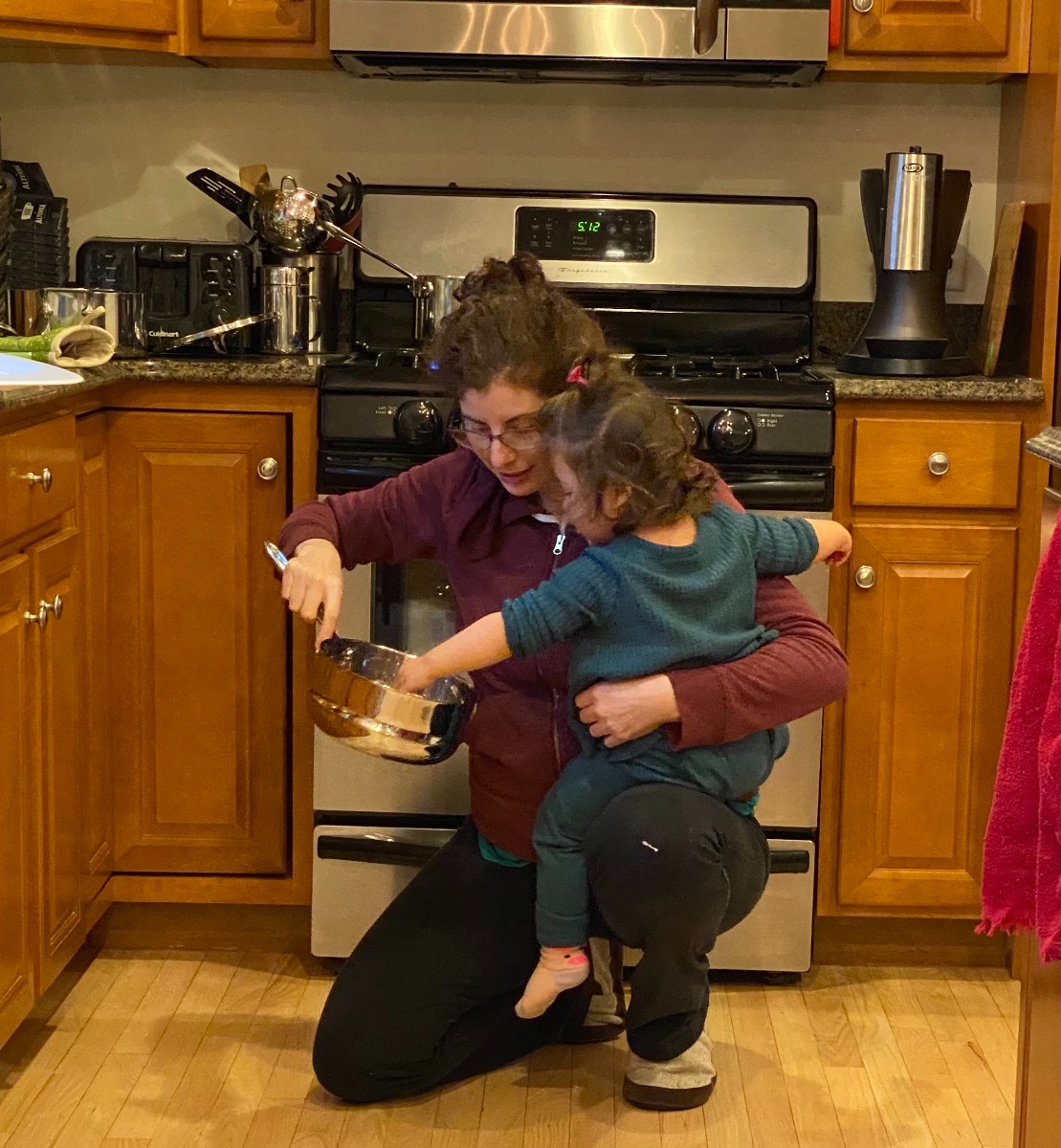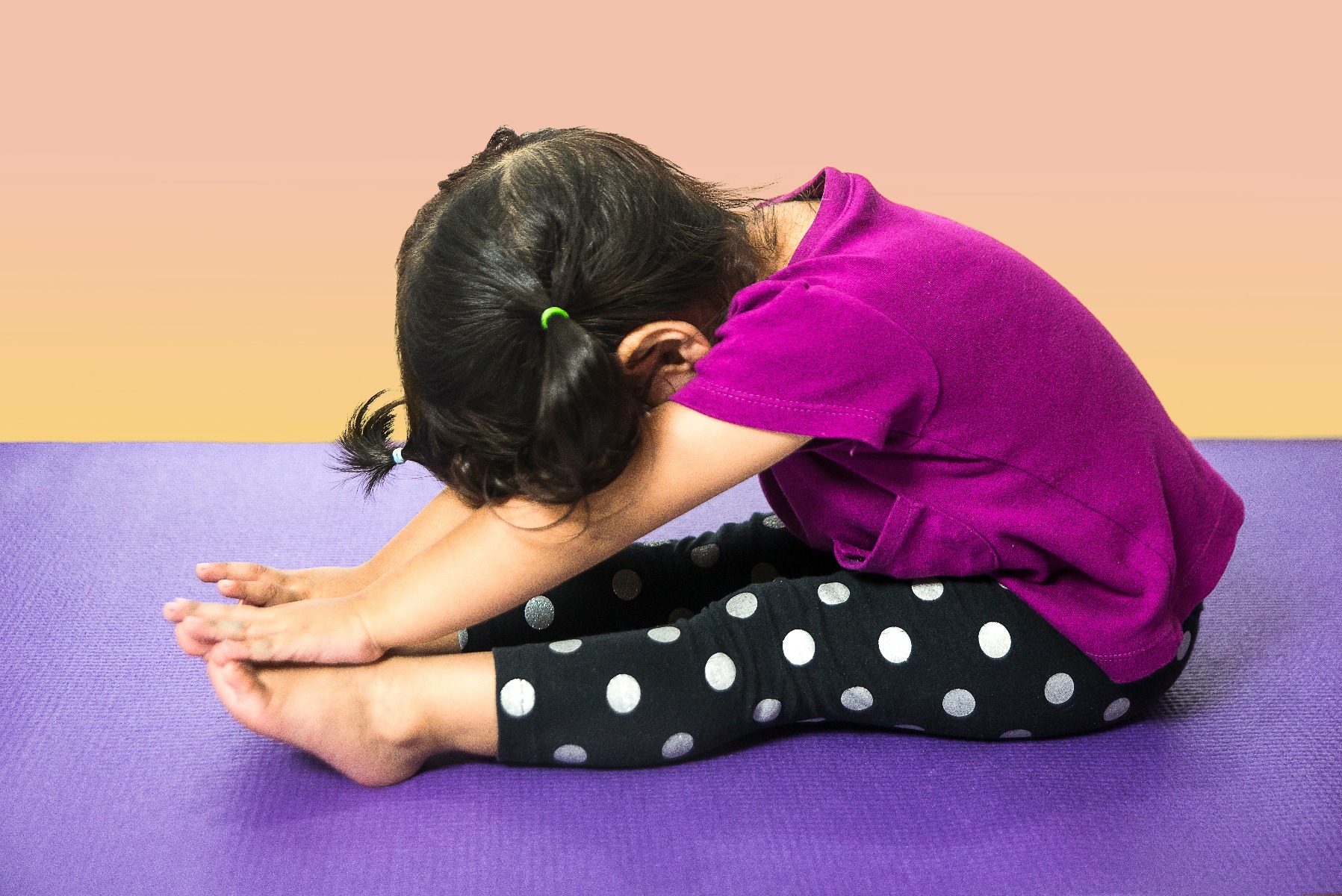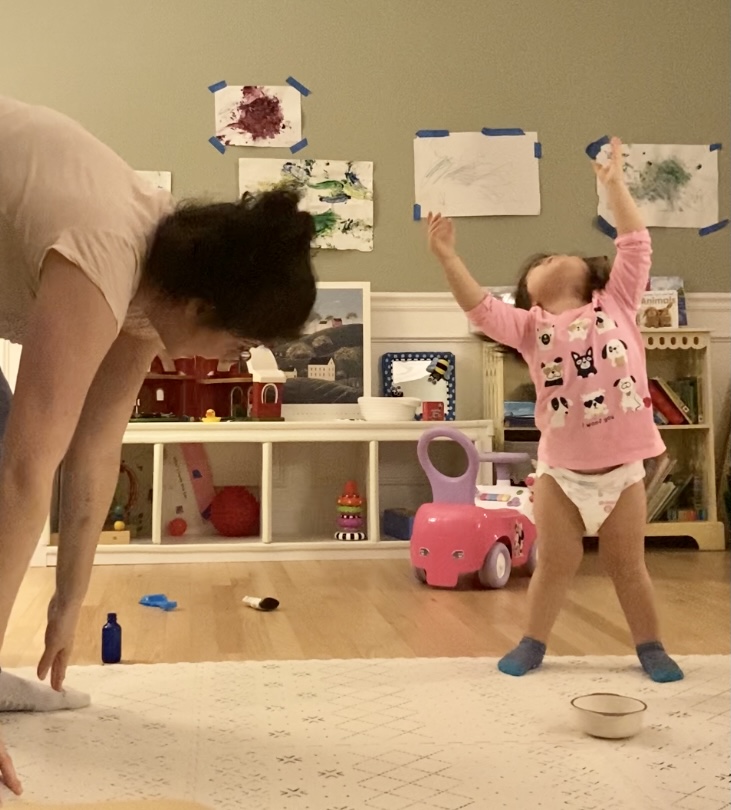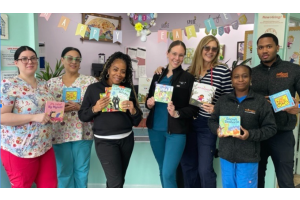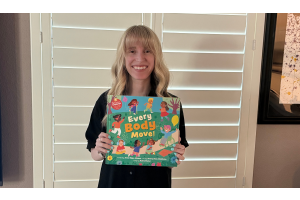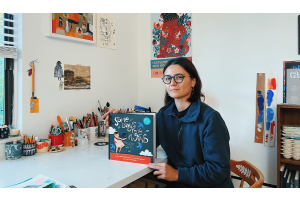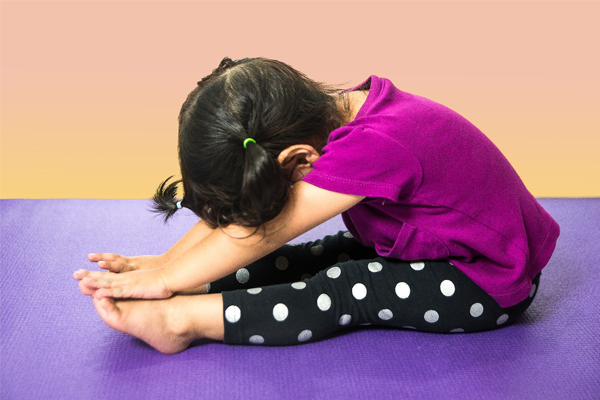
I’m not sure what I really expected when, on a whim, I introduced yoga to my toddler.
Serenely breathing and moving our bodies in unison? A super relaxing yoga sesh with my mini-me? Needless to say, it was none of those things. It was pretty adorable, though, and I was surprised by my child’s immediate and continued interest in the activity.
And so I was delighted to recently talk with my friend, Amy Hrobak, LICSW, an experienced children’s yoga teacher and mom to her own 18-month-old, to ask her for advice on starting a yoga routine with toddlers. Amy is one of those people who makes it look effortless to do movement activities with kids. I asked her to break it down for the rest of us.
Why yoga for toddlers?
My conversation with Amy made me much more aware of the benefits of yoga for toddlers. She explained, “What they’re actually doing is learning how to make different shapes with their body. They’re learning to identify and move different body parts. They’re exploring the limits of their body.
So in 15 years when they go to a yoga class, it will be like, ‘Oh I’ve made that shape with my body for years.’ Their bodies will naturally remember these shapes they’ve been making since childhood.
Yoga is one of many activities, along with music and movement, that we can do with toddlers to develop this body awareness. It’s another way of getting to know their bodies, which builds self esteem.”
Personally, I’ve also found yoga time with my toddler to be a welcome chance to stretch and move in ways that feel good for me during long stretches of caregiving. It’s not exactly “me-time,” but it definitely feels like a way to sneak in a little self-care.
Ever since talking to Amy, I’ve found home “yoga” sessions with my own toddler a lot more enjoyable, and my kiddo asks to do them every day! Here are Amy’s tips for keeping it real with yoga time for toddlers:

1. Don’t expect it to look like adult yoga
“Yoga with toddlers is not about achieving anything; it’s about exploration, fun, learning and spending time together.” According to Amy, “This is not going to be like an adult yoga class. Don’t expect them to understand how to move their body in the ways we do as adults. Their ability to internalize and process what a shape looks like and then turn their body into that shape is still developing. Toddlers’ bodies and interpretations of poses will not look entirely like the poses we are familiar with or expect. And that's okay!” She recommends simple activities like stretching, or even just basic gestures like sticking out your tongue.
“Yoga with toddlers is not about achieving anything; it’s about exploration, fun, learning and spending time together.”
2. Create a simple yoga-time association
It can be helpful to use a certain prop, like a yoga mat, or a song or a space in your home that your toddler can begin to associate with “yoga.” This is especially useful if you think your child would benefit from a structured space. Amy said that whenever she rolls out her yoga mat, her 18-month-old son, Max, immediately steps on to it and starts doing squats. He knows it’s for “exercise”! She added, though, that a yoga mat is not required for yoga with toddlers.
3. Use books for guidance
“For those parents who prefer something tangible — start with a yoga book that shows different poses. It can make you feel confident to have a guide”
Amy consulted with Barefoot Books on our new Yoga Tots series to ensure it was safe and appropriate for the youngest yogis. Strong Puppy, Calm Bunny, Brave Bear and Happy Tiger give caregivers and toddlers plenty of gentle structure for starting a mini yoga routine.
“It can make you feel confident to have a guide.”
4. View it as another form of play
“Yoga is really just another way of moving and being together. Toddlers learn through play, and so the way they will learn yoga is through play. Really just keep it simple and don’t take it too seriously. Keep it playful and organic.” Amy also recommends incorporating props that will inspire playful movement, like stuffed animals whose movements you can imitate. “You can take out the monkey and say, ‘Let’s jump like a monkey!’” She also suggests using props like shaker eggs that you can coach your toddler to shake fast, and then stop!
5. Follow their lead and always encourage
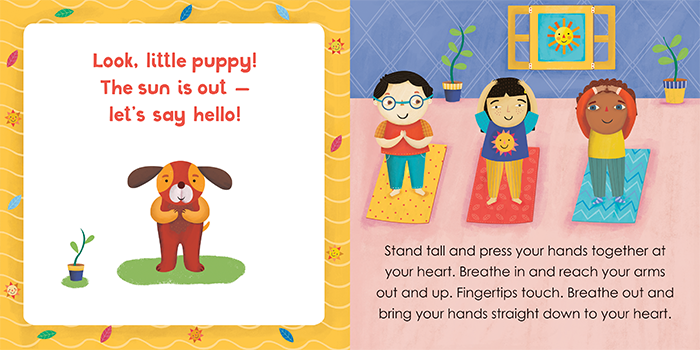
Amy emphasized, “You never want to tell them they’re doing something wrong. Ensure their safety, of course, but don’t correct their poses.” The role of the parent is to follow their lead and build. “Tree pose is a classic toddler pose, and they usually fall over. Even as they try to balance, you want to encourage them: ‘This is a very tricky pose and we get very wobbly. Wow, you were able to stay still for a second!’ If they then curl up in ball you can say, ‘Oh wow now you’re a tiny little tree.’”
8. Model the movements and ask questions
When I started out doing yoga with my own toddler, it didn’t work at all when I tried to verbally coach my child on how to move into various yoga poses. Amy explained that the best way to introduce yoga to toddlers is to model poses and movements. She also suggests asking questions. “For instance, when you’re both in snake pose, you can ask your child, ‘What do you notice? Do you feel a stretch in your belly? Which parts of your body can you move when you’re in this pose? Do you like how this feels?’”
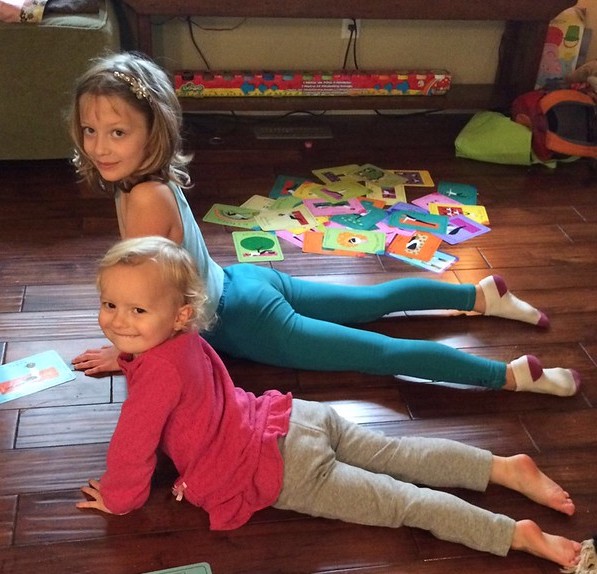
9. Try using songs as a starting point
Songs and fingerplays can be the basis for toddler yoga when you turn them into full body experiences. “Songs are a vehicle you can use to bring yoga into the play. For example, Itsy Bitsy Spider. You can do the movements and change pace, fast and then slow. You can focus on and exaggerate certain movements that go with the song. The goal is to get them really excited and then switch gears to go slow. Or you could be a huge full-body spider and then a tiny spider. This helps them practice self regulation.”
Amy explained that it’s the intentionality around these activities — the goal of reciprocal movement — that qualifies them as “yoga” for toddlers.
10. Breathe together
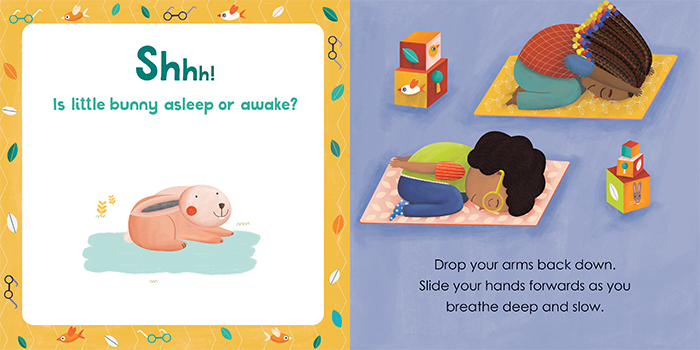
Lastly, Amy advised that simply breathing together can be a form of yoga. “Breath and breathing are such a big part of yoga — they are what make yoga distinct from other types of movement. I’ve heard teachers say that even if you just sit here and breathe you’re doing yoga.” She suggests having little kids put their hands on their heart and take a deep breath three times. “You could do this at the start and at the end of your yoga sessions to give them some structure. It gets them familiar with knowing what their breath feels like and sounds like.”
She added, “In toddlerhood we introduce breathing through props and imagination: blowing pinwheels, smelling pretend hot cocoa or a pretend flower, blowing out a pretend candle, etc. The connection of movement and breath is tricky in toddlerhood as a concept, but we begin to introduce it at this age in these ways.”
Even if you can only remember one or two of these tips, I think you’ll find, as I did, that they really help shape a fun new activity to do together that benefits everyone involved. No matter what direction your yoga sessions take, try to go with the flow. And congratulate yourself on doing something creative with your toddler!
About Amy Hrobak, LICSW
Amy has been both practicing and teaching yoga since 2010. Profoundly beneficial and complimentary to her yoga teaching is Amy’s professional experience as a Licensed Independent Clinical Social Worker for children and teens, which lays the foundation for her highly sensitive and compassionate approach. Since 2002 she has worked with hundreds of children, teens and families in a therapeutic capacity.
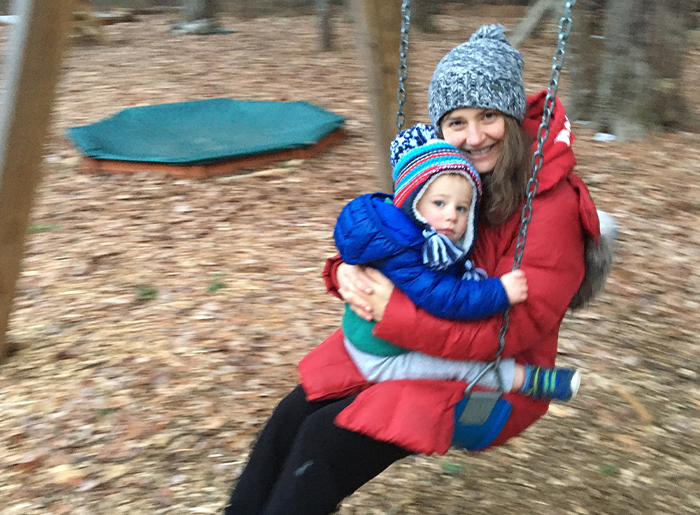
She recently served as the expert consultant on Barefoot Books’ Yoga Tots series.
Amy has completed her 200-hour Yoga Teacher training with Chanel Luck and Bonnie Argo of Radiant Yoga Boston, KidPowerment 100-hour Childrens’ Yoga Training, Circus Yoga and Soulful Yoga Therapy. Through yoga Amy supports children and teens in finding peace, safety, and calm within themselves, as well as promoting a connection with themselves and others. In Amy’s child and teen classes, students learn and grow through play, teamwork, focus, confidence building and body awareness while building strength and flexibility in their bodies.
Amy’s most recent student is her 18-month-old son, Max.
You can find Amy at www.heartsandmindsyoga.com and [email protected].
About Stefanie Paige Wieder, M.S.Ed
Stefanie is the Director of Education & Content at Barefoot Books and a child development expert with over 25 years of experience working with schools, clinical settings and children’s products. She and her toddler love practicing yoga together, in whatever form that takes!
To correspond with Stefanie please contact her at [email protected].
